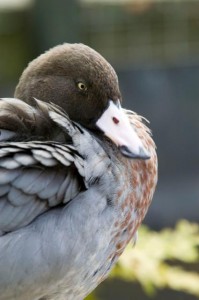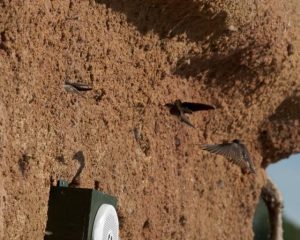The morning feed
Feb 12 by Paul Stevens
I am doing the morning feed today. Water levels are high on the reserve after heavy rains. Wild gulls and mallard can interfere with the morning feed, scaring away the captive birds in our collection to get at the food. The gulls especially go after the floating marine pellet. High water levels on neighbouring fields have attracted the wild gulls and mallards so there is less competition during the feed.
We have over 50 species of wildfowl from around the world in our captive collection at Arundel Wetland Centre. We do two feeds a day and count all the birds each feed. Eider ducks are displaying, heads bobbing with their distinctive ‘Ay-oo’ call across the water at World Wetlands. In the Reed Swamp exhibit its the Geiger counter clicking of the garganey ducks I hear as they gather below the deck near the submerged feeding platform.
In the Lakes and Forest exhibit wild pochard ducks have joined their North American cousins, the canvas back ducks, from our collection.

At the Waterfall Pen, Jerry the blue duck bites at my arm as I refill his food bowl. I have the privilege of being attacked by one of the rarest ducks in the world. Blue ducks are no longer exported outside of New Zealand and Jerry is the last blue duck in the UK. Jerry also eats tiny freshwater shrimp that live in then waterfall, as well as his pellets and nibbling on WWT staff.
Our juvenile harlequin ducks on the other side of the waterfall pen are colouring up nicely, the white spots behind their eyes is well defined and the male of the trio is turning a deeper chestnut colour with a white band near his neck. The harlequins are nick-named sea mice for their squeaky call. These three are the only ones that were successfully produced in captive breeding programs across all of Europe in 2012. The sea ducks are difficult to breed in captivity. Our special Icelandic pen has the fast flowing water these ducks like to nest near. We are doing minor improvements on the pen to create more nesting surfaces for the harlequins and our mergansers to nest.
Entering reedbed boardwalk I hear a woodpecker drumming along the fence-line. At the woodland carr a reed bunting sits in on willow singing away. This must be the same fellow I heard singing in the rainstorm yesterday. I hear a mistle thrush across the reedbed. They are often called storm cocks as they sing in bad weather as well. Catkins are sprouting on the sallow willow here in the reedbed.
A dunnock sings as I approach the Scrape hide. Visitors were still reporting bittern sightings last week but these maybe coming to an end with the weather warming up a bit. There are 12 snipe on the fencut to the left of the hide, 2 shelducks on the water and I hear water rails calling in the reedbed.

Seeing the Sand Martin hide reminds of recent reports that some sand martins and swifts have already made it across the Sahara desert on their spring migration. I have great hopes for the sand martins nesting in our artificial nesting bank, based on the huge amount of hirundine visitors we had visit the bank on the autumn migration south.
From the Sand Martin hide windows I count 11gadwall, 9 lapwing, 16 shelduck and 14 teal. Twelve snipe sit on the islands along the back near a grey heron. A handful of black headed gulls sit on the long island with two common gulls in the mix. Suddenly a kingfisher flashes in from direction of Scrape hide to perch up at scrub along back of water.
In the Wildlife Garden I watch a female bullfinch scavenge seeds from the ground, that have fallen from the dead seed heads. A woodpecker starts drumming from direction of our car park.
At the lapwing hide I find 10 teal, a nice surprise, glad to see they are find enough found on this new ecosystem of this field. The winter flood waters have helped by bring more insect larvae and seeds in through the sluices.
